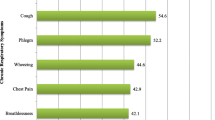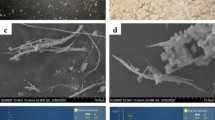Summary
Seventy-three men and women exposed to phenolic resin dust and/or processed cotton dust in a factory producing sound-deadening material were studied cross-sectionally. There was a statistically significant acute drop in FEV1 and FVC over the shift in garnett-line workers exposed to dust containing phenolic resin. Pickers, exposed to processed cotton dust only, did not show a significant drop in FEV1 and FVC over the work shift. Thirty-five percent of the workers that had smoked cigarettes and had worked in the plant 5 years or more had an FEV1 less than 80% of predicted. This finding was not entirely explained by duration of cigarette smoking. Multiple regression analysis revealed that the longer the duration of exposure, the lower the ratio of FEV1 to FVC. Respiratory symptoms were related to current cigarette smoking but not to duration of employment. The study suggests that exposure to dust containing phenolic resin had both acute and chronic effects on pulmonary function.
Similar content being viewed by others
References
National Institute of Occupational Safety and Health: Occupational diseases: a guide to their recognition. US Government Printing Office 1977
Shoenberg, J. B., Mitchel, C. A.: Airway disease caused by phenolic (phenol-formaldehyde) resin exposure. Arch Environ. Health 30, 574–577 (1975)
Gamble, J. F., McMichael, A. J., Williams, T., Battigelli, M.: Respiratory function and symptoms: an environmental-epidemiological study of rubber workers exposed to a phenolformaldehyde type resin. Am. Ind. Hyg. Assoc. J. 499–512 (1976)
Medical research council's committee on the etiology of chronic bronchitis: Standardized questionnaires on respiratory symptoms. Br. Med. J. 2, 1665 (1960)
Knudson, R. J., Slatin, R. C., Lebowitz, M. D., Burrows, B.: The maximal expiratory flow volume curve: Normal standards, variability, and the effects of age. Am. Rev. Respir. Dis. 113, 587–600 (1976)
Nie, N. H., Hull, C. H., Jenkins, J. G., Steinbrenner, K., Bent, D. H.: Statistical package for the social sciences, 2nd ed. New York: McGraw Hill 1975
Guberan, M. K. E., Walford, J., Smith, M. M.: Circadian variation of FEV in shift workers. Br. J. Ind. Med. 26, 121–125 (1969)
Fine, L. J., Peters, J. M., Burgess, W. A., DiBerardinis, L. J.: Studies of respiratory morbidity in rubber workers. Part IV, Respiratory morbidity in talc workers. Arch. Environ. Health 31, 195–200 (1976)
Author information
Authors and Affiliations
Rights and permissions
About this article
Cite this article
Sparks, P.J., Peters, J.M. Respiratory morbidity in workers exposed to dust containing phenolic resin. Int. Arch Occup Environ Heath 45, 221–229 (1980). https://doi.org/10.1007/BF00380786
Received:
Accepted:
Issue Date:
DOI: https://doi.org/10.1007/BF00380786




